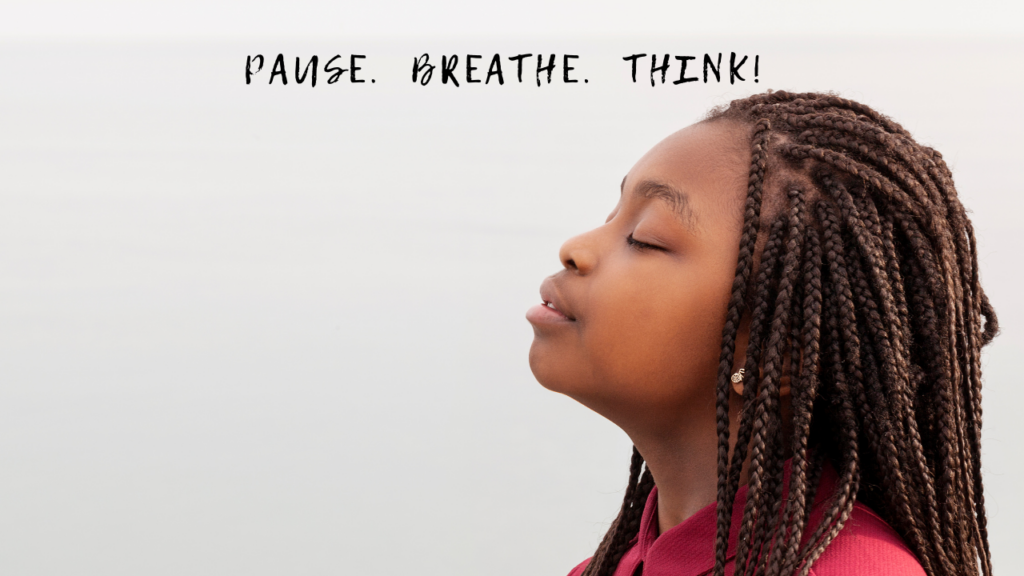Has this ever happened to you? You’re in your kitchen when, without thinking, you grab the lid off a hot pot with your bare hands. What happens next? If your first instinct is to yank your hand away, congratulations! You’ve just demonstrated a classic example of an impulse – an automatic reaction without much thought. But what happens if we take a moment to pause and think before acting? Today we are exploring the art of controlling impulses through a simple recipe: “Pause. Breathe. Think.”
Impulses Aren’t Always Bad
Impulses are like your brain’s built-in safety alarms. They can keep you out of harm’s way, like pulling your hand from a hot pot lid. In these situations, quick action is crucial. But what if we apply this concept to our interactions with others?
Impulsive Mishaps
Have you ever blurted out something you instantly regretted or done something that seemed brilliant at the moment but upset others later? We’ve all been there, and it can be incredibly awkward and embarrassing. These are the moments when impulsive actions can create problems or make existing ones worse.
A Recipe for Success
Pause. Breathe. Think. Before you act, it’s essential to remember the power of pausing, taking a breath, and thinking things through. When your mind and body are calm, you can think clearly and control your impulses, leading to more thoughtful reactions and problem-solving.
The Role of Emotions
Emotions can sometimes overwhelm your thinking, especially big and intense ones like excitement or anger. When these emotions take over, your ability to think clearly diminishes. That’s why it’s crucial to pause and breathe, giving your emotions time to settle.
Calming the Storm
How can you make your emotions settle? One simple tool is your breath. It’s always with you, and there are various techniques you can use, like belly breathing, trace-a-shape breathing, or even visualizing relaxing colors. Your breath acts as a pause button between your emotions and your reactions, providing the oxygen and time needed to think clearly and control your impulses.
Little Life Lessons • Big Life Skills
The next time you feel strong emotions bubbling up inside you, remember this recipe for success: Pause. Breathe. Think. By taking a moment to apply these steps, you can gain better control over your impulses and be more thoughtful with your words and actions. You’ll not only make better choices but also improve your relationships with others.Try it out, and see how mastering this recipe can lead to better emotional regulation and smoother interactions. Until next time!
Books Related to this Topic

Oh No, George! is among my favorites for teaching self-control. George is a dog with all the best intentions, and his owner, Harry, has all the best hopes that George will be a well-behaved dog when he leaves him alone for the day. But it’s so hard to be a good dog when there are cats to chase and flowers to dig up! I use it to talk about what it means to “be good” and what “good” looks like, sounds like, etc. in our classroom community.
Sometimes I’m Bombaloo! explores big emotions and tantrums in this heartwarming story. Follow Katie Honors, who sometimes turns into Bombaloo when things go wrong. With love and understanding from her mom, she learns to calm down and be herself again. A great springboard for talking about what your body feels like when you lose control.
When Miles Got Mad When a favorite toy breaks, Miles is consumed by rage, and a red furry monster appears in the mirror. Through the guidance of the Mad Monster, Miles learns to tame his anger by using words to express his feelings. He starts talking about why he is mad and immediately begins to calm down and his anger shrinks.This resource is a powerful tool for teaching self-regulation and coping with anger. It illustrates the value of talking about emotions to find calmness.
Fergal and the Bad Temper is all about emotions associated when “It’s not fair!” Fergal the dragon does not like when things don’t go his way. And when things aren’t fair, Fergal loses his temper and snorts angry fire. His fiery temper causes a lot of trouble. Eventually his friends don’t want to play with him. After one really fiery day, his family and friends offer him some advice to calm down. This book illustrates common triggers for kids and offers a variety of ways to calm a fiery temper.
Sam’s Pet Temper One day at the playground, Sam faces endless waiting and gets really, really mad. Suddenly, something extraordinary appears – a mischievous creature known as a Temper. At first, having a Temper is fun, but then trouble begins, and Sam realizes it’s actually his own anger that is causing the chaos. As the story unfolds, Sam learns the importance of taming his Temper. This is a great story for gently teaching kids about controlling anger and taking responsibility. It’s a wonderful fit for lessons on self-discipline, patience, and understanding emotions.
Crankenstein is the monster of crankiness! No one’s immune to feeling cranky, especially kids. From early wake-up calls to stingy Halloween candy givers, Crankenstein emerges. This cranky monster groans “MEHHRRRR!” in response to life’s annoyances. After kids learn strategies for managing life’s annoyances, they may have some good strategies to help Crankenstein out of his cranky mood.
Cranium Critters: Paws at the Pause Place introduces young readers to Scout and Einstein, two lovable characters who represent different parts of the brain. Scout, the brain’s safety pup, is ever-vigilant in safeguarding us by sending out alerts when she senses potential danger. Einstein, the brain’s head thinker, is the mastermind behind decision-making and problem-solving. Through their adventures, children discover the significance of the amygdala and prefrontal cortex, the brain’s fight, flight, and freeze response, and essential strategies to manage their emotions and anxieties.

